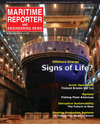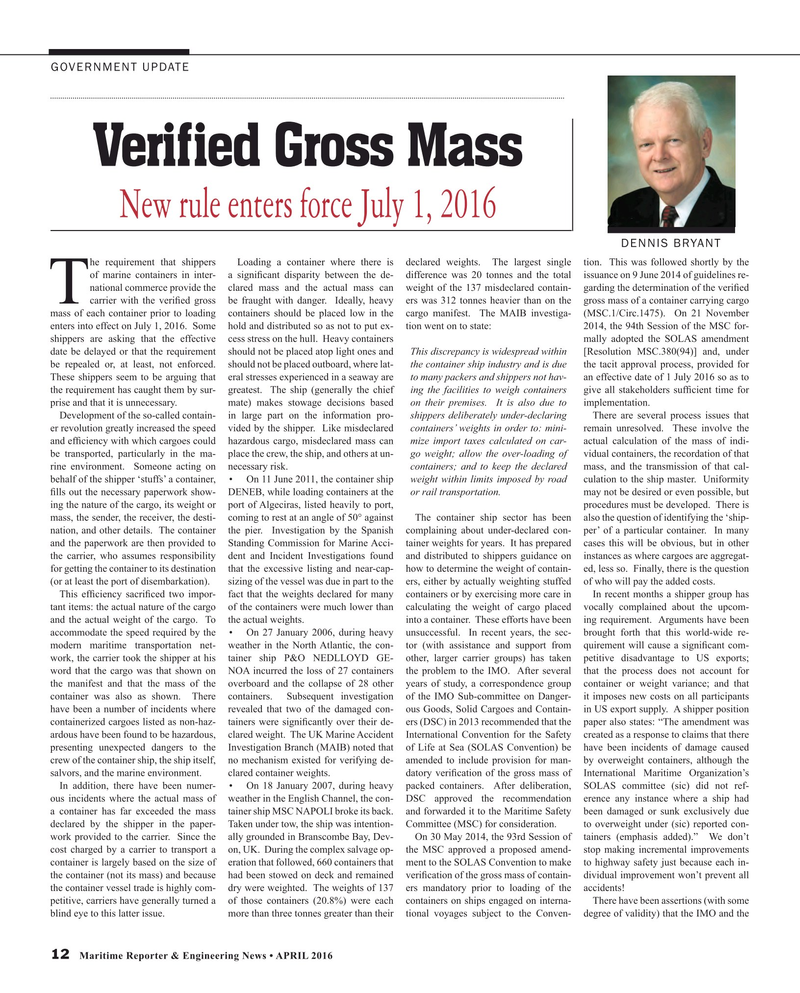
Page 12: of Maritime Reporter Magazine (April 2016)
The Offshore Annual
Read this page in Pdf, Flash or Html5 edition of April 2016 Maritime Reporter Magazine
GOVERNMENT UPDATE
Veri? ed Gross Mass
New rule enters force July 1, 2016
DENNIS BRYANT he requirement that shippers Loading a container where there is declared weights. The largest single tion. This was followed shortly by the of marine containers in inter- a signi? cant disparity between the de- difference was 20 tonnes and the total issuance on 9 June 2014 of guidelines re- national commerce provide the clared mass and the actual mass can weight of the 137 misdeclared contain- garding the determination of the veri? ed
Tcarrier with the veri? ed gross be fraught with danger. Ideally, heavy ers was 312 tonnes heavier than on the gross mass of a container carrying cargo mass of each container prior to loading containers should be placed low in the cargo manifest. The MAIB investiga- (MSC.1/Circ.1475). On 21 November enters into effect on July 1, 2016. Some hold and distributed so as not to put ex- tion went on to state: 2014, the 94th Session of the MSC for- shippers are asking that the effective cess stress on the hull. Heavy containers mally adopted the SOLAS amendment date be delayed or that the requirement should not be placed atop light ones and This discrepancy is widespread within [Resolution MSC.380(94)] and, under be repealed or, at least, not enforced. should not be placed outboard, where lat- the container ship industry and is due the tacit approval process, provided for
These shippers seem to be arguing that eral stresses experienced in a seaway are to many packers and shippers not hav- an effective date of 1 July 2016 so as to the requirement has caught them by sur- greatest. The ship (generally the chief ing the facilities to weigh containers give all stakeholders suf? cient time for prise and that it is unnecessary. mate) makes stowage decisions based on their premises. It is also due to implementation.
Development of the so-called contain- in large part on the information pro- shippers deliberately under-declaring There are several process issues that er revolution greatly increased the speed vided by the shipper. Like misdeclared containers’ weights in order to: mini- remain unresolved. These involve the and ef? ciency with which cargoes could hazardous cargo, misdeclared mass can mize import taxes calculated on car- actual calculation of the mass of indi- be transported, particularly in the ma- place the crew, the ship, and others at un- go weight; allow the over-loading of vidual containers, the recordation of that rine environment. Someone acting on necessary risk. containers; and to keep the declared mass, and the transmission of that cal- behalf of the shipper ‘stuffs’ a container, • On 11 June 2011, the container ship weight within limits imposed by road culation to the ship master. Uniformity ? lls out the necessary paperwork show- DENEB, while loading containers at the or rail transportation. may not be desired or even possible, but ing the nature of the cargo, its weight or port of Algeciras, listed heavily to port, procedures must be developed. There is mass, the sender, the receiver, the desti- coming to rest at an angle of 50° against The container ship sector has been also the question of identifying the ‘ship- nation, and other details. The container the pier. Investigation by the Spanish complaining about under-declared con- per’ of a particular container. In many and the paperwork are then provided to Standing Commission for Marine Acci- tainer weights for years. It has prepared cases this will be obvious, but in other the carrier, who assumes responsibility dent and Incident Investigations found and distributed to shippers guidance on instances as where cargoes are aggregat- for getting the container to its destination that the excessive listing and near-cap- how to determine the weight of contain- ed, less so. Finally, there is the question (or at least the port of disembarkation). sizing of the vessel was due in part to the ers, either by actually weighting stuffed of who will pay the added costs.
This ef? ciency sacri? ced two impor- fact that the weights declared for many containers or by exercising more care in In recent months a shipper group has tant items: the actual nature of the cargo of the containers were much lower than calculating the weight of cargo placed vocally complained about the upcom- and the actual weight of the cargo. To the actual weights. into a container. These efforts have been ing requirement. Arguments have been accommodate the speed required by the • On 27 January 2006, during heavy unsuccessful. In recent years, the sec- brought forth that this world-wide re- modern maritime transportation net- weather in the North Atlantic, the con- tor (with assistance and support from quirement will cause a signi? cant com- work, the carrier took the shipper at his tainer ship P&O NEDLLOYD GE- other, larger carrier groups) has taken petitive disadvantage to US exports; word that the cargo was that shown on NOA incurred the loss of 27 containers the problem to the IMO. After several that the process does not account for the manifest and that the mass of the overboard and the collapse of 28 other years of study, a correspondence group container or weight variance; and that container was also as shown. There containers. Subsequent investigation of the IMO Sub-committee on Danger- it imposes new costs on all participants have been a number of incidents where revealed that two of the damaged con- ous Goods, Solid Cargoes and Contain- in US export supply. A shipper position containerized cargoes listed as non-haz- tainers were signi? cantly over their de- ers (DSC) in 2013 recommended that the paper also states: “The amendment was ardous have been found to be hazardous, clared weight. The UK Marine Accident International Convention for the Safety created as a response to claims that there presenting unexpected dangers to the Investigation Branch (MAIB) noted that of Life at Sea (SOLAS Convention) be have been incidents of damage caused crew of the container ship, the ship itself, no mechanism existed for verifying de- amended to include provision for man- by overweight containers, although the salvors, and the marine environment. clared container weights. datory veri? cation of the gross mass of International Maritime Organization’s
In addition, there have been numer- • On 18 January 2007, during heavy packed containers. After deliberation, SOLAS committee (sic) did not ref- ous incidents where the actual mass of weather in the English Channel, the con- DSC approved the recommendation erence any instance where a ship had a container has far exceeded the mass tainer ship MSC NAPOLI broke its back. and forwarded it to the Maritime Safety been damaged or sunk exclusively due declared by the shipper in the paper- Taken under tow, the ship was intention- Committee (MSC) for consideration. to overweight under (sic) reported con- work provided to the carrier. Since the ally grounded in Branscombe Bay, Dev- On 30 May 2014, the 93rd Session of tainers (emphasis added).” We don’t cost charged by a carrier to transport a on, UK. During the complex salvage op- the MSC approved a proposed amend- stop making incremental improvements container is largely based on the size of eration that followed, 660 containers that ment to the SOLAS Convention to make to highway safety just because each in- the container (not its mass) and because had been stowed on deck and remained veri? cation of the gross mass of contain- dividual improvement won’t prevent all the container vessel trade is highly com- dry were weighted. The weights of 137 ers mandatory prior to loading of the accidents!
petitive, carriers have generally turned a of those containers (20.8%) were each containers on ships engaged on interna- There have been assertions (with some blind eye to this latter issue. more than three tonnes greater than their tional voyages subject to the Conven- degree of validity) that the IMO and the 12 Maritime Reporter & Engineering News • APRIL 2016
MR #4 (10-17).indd 12 4/6/2016 4:55:53 PM

 11
11

 13
13
